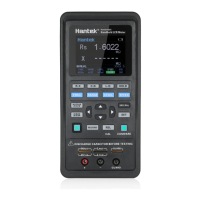10
1. Turn on the instrument and the measurement display is shown, the component with required
nominal should be placed on the test clip of the instrument.
2. Long press [COMPARE] to turn on the comparator, and the nominal value is the value of the
measured element.
The nominal value and tolerance will be displayed in the status bar as shown in the below figure.
The deviation value between current test value and standard value will display on the secondary
parameter position.
Short press this key to select the required tolerance value successively (1%, 5%, 10% and 20%
optional). The color bar at the top of the screen will be used to judge GOOD/NG.
Long press this button or change the primary and secondary parameters to exit this function.
Note: This function cannot work if the main parameter select as Auto.
2.2.8 Equivalent mode
Due to the non-ideal and distributed parameters of component, the actual components tend to be
equivalent with the combination of ideal elements. Generally LCR tester uses two simple
equivalent models--series and parallel. Selecting the proper equivalent model will lead to better
measurement results. In general, low-impedance elements (such as that below 100Ω) should use
the series equivalent model; a high impedance element (such as that above 10kΩ) should use the
parallel equivalent model; the equivalent model affects less the measurement result of the one in
between the two above models.
Press [SER/PAL] key to switch equivalent mode (SER, PAL).
2.3 Relative mode
Press [REL] to turn on the relative function and the current value is used as reference. The
reference value and relative value will be shown respectively on the secondary and main display.
Press the key again to exit the function.

